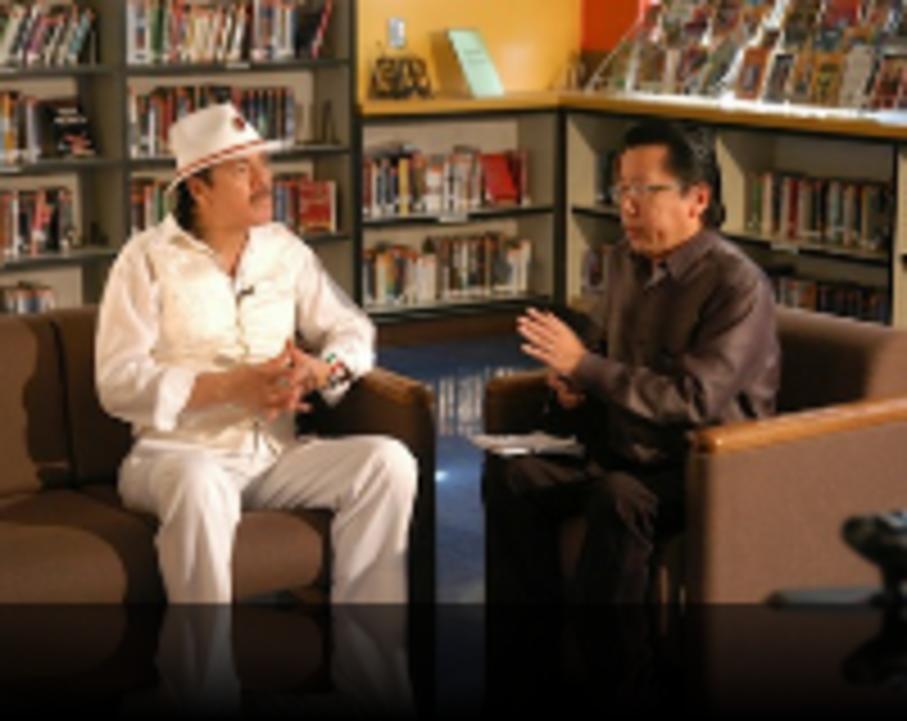Happy Birthday and Hats Off to Carlos Santana

What a shock the NBA Finals were for a lot of fans of the Golden State Warriors.
No, I don’t mean losing to the Cleveland Cavaliers. I mean seeing Carlos Santana playing the National Anthem in Game 2, accompanied by his wife and drummer, Cindy Blackman Santana.
As they did in last year’s Finals, they performed brilliantly. The surprise was that Carlos went hatless, exposing a James Taylor-like dome. A shock and I say salud.
Watch Santana's performance on Stingray Qello
On his 69th birthday, which took place on July 20, he should embrace his age. After all, he’s never slowed down. Now doing a residency at the House of Blues in Las Vegas, he recently issued a reunion album, Santana IV, with most of the original band members playing together for the first time in some 45 years.
That’s about when I first interviewed him and the guys, for the cover of Rolling Stone. Since then, I’ve seen him numerous times, at places ranging from onstage at the Castro Theater in San Francisco (for his memoir, The Universal Tone, published in ’14) to Mission High School, where he and Cindy visited one day, and where he joined awed music students in a jam).
I also interviewed him, in 2003, for Parade magazine, at his band’s offices and studios in Marin County, where he spoke about being born in Mexico. When his family moved from Tijuana to San Francisco in the early Sixties, Carlos hid from them and stayed behind. In his teens, he was playing guitar in bars and strip joints. “I wanted to stay in an environment in Tijuana where I was around grown-up musicians and prostitutes,” he told me. “I said, this is my university right here, this is where you learn the real music, man!”
Months later, his parents returned to fetch him. “They brought me here kicking and biting,” he says, explaining that he didn’t want to attend school in San Francisco, and that, having been raised on the blues of B.B. King and Muddy Waters and others, he didn’t want to be “bombarded” with American pop music.
But it was while attending Mission High that he formed the nucleus of the Santana Blues Band; it was in San Francisco that he discovered the Fillmore Auditorium and met Bill Graham, who would become a friend mentor, getting Santana onto the bill at the Woodstock Festival.
Carlos told me he knew his band had made it when he saw a football highlights show on television. “All of a sudden they were playing music that sounded just like Santana. And I said, ‘Oh…I see!’ Next thing you know, Chicago’s got congas and timbales. The Rolling Stones, Jimi Hendrix, everybody had congas.”
Since achieving stardom, Santana has not been shy about expressing concerns about American culture and politics. He told me his second all-star album was called Shaman because “a shaman is a spiritual healer, and we all need a serious healing right now, from a vibration of anger and fear, over-the-top patriotism that almost borders on blind. I think humanity should have a higher priority than any nation.”
He said that in 2003.
 Carlos Santana and Ben Fong-Torres at Mission High a couple of years ago.
Carlos Santana and Ben Fong-Torres at Mission High a couple of years ago.
Ben Fong-Torres was a writer and editor at Rolling Stone from 1969 to 1981. He was a DJ on KSAN, has published ten books, writes the Radio Waves column in the Chronicle, and created the online station, Moonalice Radio, where his DJ show runs from 9 to 12, day and night.
This article was originally published on qello.com. Reproduced with permission from the author.
